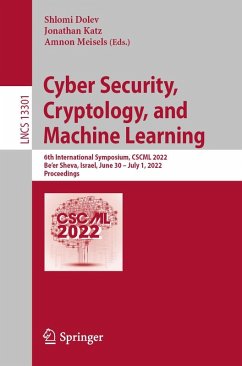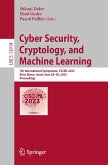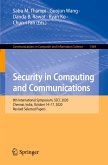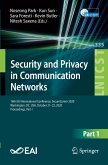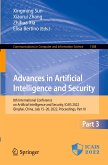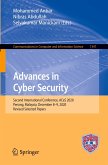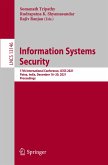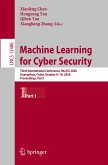Cyber Security, Cryptology, and Machine Learning
6th International Symposium, CSCML 2022, Be'er Sheva, Israel, June 30 - July 1, 2022, Proceedings
Herausgegeben:Dolev, Shlomi; Katz, Jonathan; Meisels, Amnon
Cyber Security, Cryptology, and Machine Learning
6th International Symposium, CSCML 2022, Be'er Sheva, Israel, June 30 - July 1, 2022, Proceedings
Herausgegeben:Dolev, Shlomi; Katz, Jonathan; Meisels, Amnon
- Broschiertes Buch
- Merkliste
- Auf die Merkliste
- Bewerten Bewerten
- Teilen
- Produkt teilen
- Produkterinnerung
- Produkterinnerung
This book constitutes the refereed proceedings of the 6th International Symposium on Cyber Security Cryptography and Machine Learning, CSCML 2022, held in Be'er Sheva, Israel, in June - July 2022.
The 24 full and 11 short papers presented together with a keynote paper in this volume were carefully reviewed and selected from 53 submissions. They deal with the theory, design, analysis, implementation, or application of cyber security, cryptography and machine learning systems and networks, and conceptually innovative topics in these research areas.
Andere Kunden interessierten sich auch für
![Cyber Security, Cryptology, and Machine Learning Cyber Security, Cryptology, and Machine Learning]() Cyber Security, Cryptology, and Machine Learning76,99 €
Cyber Security, Cryptology, and Machine Learning76,99 €![Security in Computing and Communications Security in Computing and Communications]() Security in Computing and Communications38,99 €
Security in Computing and Communications38,99 €![Security and Privacy in Communication Networks Security and Privacy in Communication Networks]() Security and Privacy in Communication Networks76,99 €
Security and Privacy in Communication Networks76,99 €![Advances in Artificial Intelligence and Security Advances in Artificial Intelligence and Security]() Advances in Artificial Intelligence and Security98,99 €
Advances in Artificial Intelligence and Security98,99 €![Advances in Cyber Security Advances in Cyber Security]() Advances in Cyber Security76,99 €
Advances in Cyber Security76,99 €![Information Systems Security Information Systems Security]() Information Systems Security49,99 €
Information Systems Security49,99 €![Machine Learning for Cyber Security Machine Learning for Cyber Security]() Machine Learning for Cyber Security76,99 €
Machine Learning for Cyber Security76,99 €-
-
-
This book constitutes the refereed proceedings of the 6th International Symposium on Cyber Security Cryptography and Machine Learning, CSCML 2022, held in Be'er Sheva, Israel, in June - July 2022.
The 24 full and 11 short papers presented together with a keynote paper in this volume were carefully reviewed and selected from 53 submissions. They deal with the theory, design, analysis, implementation, or application of cyber security, cryptography and machine learning systems and networks, and conceptually innovative topics in these research areas.
The 24 full and 11 short papers presented together with a keynote paper in this volume were carefully reviewed and selected from 53 submissions. They deal with the theory, design, analysis, implementation, or application of cyber security, cryptography and machine learning systems and networks, and conceptually innovative topics in these research areas.
Produktdetails
- Produktdetails
- Lecture Notes in Computer Science 13301
- Verlag: Springer / Springer International Publishing / Springer, Berlin
- Artikelnr. des Verlages: 978-3-031-07688-6
- 1st ed. 2022
- Seitenzahl: 524
- Erscheinungstermin: 31. Mai 2022
- Englisch
- Abmessung: 235mm x 155mm x 29mm
- Gewicht: 785g
- ISBN-13: 9783031076886
- ISBN-10: 3031076885
- Artikelnr.: 63985687
- Herstellerkennzeichnung
- Springer-Verlag KG
- Sachsenplatz 4-6
- 1201 Wien, AT
- ProductSafety@springernature.com
- Lecture Notes in Computer Science 13301
- Verlag: Springer / Springer International Publishing / Springer, Berlin
- Artikelnr. des Verlages: 978-3-031-07688-6
- 1st ed. 2022
- Seitenzahl: 524
- Erscheinungstermin: 31. Mai 2022
- Englisch
- Abmessung: 235mm x 155mm x 29mm
- Gewicht: 785g
- ISBN-13: 9783031076886
- ISBN-10: 3031076885
- Artikelnr.: 63985687
- Herstellerkennzeichnung
- Springer-Verlag KG
- Sachsenplatz 4-6
- 1201 Wien, AT
- ProductSafety@springernature.com
Blind Rotation in Fully Homomorphic Encryption with Extended Keys.- Monitoring Time Series With Missing Values: a Deep Probabilistic Approach.- Time, Memory and Accuracy Tradeoffs in Side-Channel Trace Profiling.- Design of Intrusion Detection System based on Logical Analysis of Data (LAD) using Information Gain Ratio.- Simulating a Coupon Collector.- On the undecidability of the Panopticon detection problem.- Privacy-Preserving Contrastive Explanations with Local Foil Trees.- Timing leakage analysis of non-constant-time NTT implementations with Harvey butterflies.- Predicting the direction of changes in the values of time series for relatively small training samples.- Machine-Learning Based Objective Function Selection for Community Detection.- Randomness for Randomness Testing.- Botnet attack identification based on SDN.- Setting up an anonymous gesture database as well as enhancing it with a verbal script simulator for rehabilitation applications.- Fake News Detection in Social Networks using Machine Learning and Trust.- Reinforcement Based User Scheduling for Cellular Communications.- A Heuristic Framework to search for Approximate Mutually Unbiased Bases.- Counter Mode for Long Messages and a Long Nonce.- Transfer learning for time series classification using synthetic data generation.- Non-Stopping Junctions via Traffic Scheduling.- Predicting subscriber usage: Analyzing multidimensional time-series using Convolutional Neural Networks.- Smart Cybercrime Classification for Digital Forensics with Small Datasets.- Auditable, Available and Resilient Private Computation on the Blockchain via MPC.- Union Buster: A Cross-Container Covert-Channel Exploiting Union Mounting.- Mutual Accountability Layer: Accountable Anonymity within Accountable Trust.- Faster Post-Quantum TLS handshakes Without Intermediate CA Certificates.- Enhancing Cybersecurity of Satellites at sub-THz Bands.- Polynomial Approximation of Inverse sqrt Function for FHE.- Detecting Clickbait in Online Social Media: You Won't Believe How We Did It.- Etherless Ethereum Tokens: Simulating Native Tokens in Ethereum.- A Linear-Time 2-Party Secure Merge Protocol.- FairMM: A Fast and Frontrunning-Resistant Crypto Market-Maker.-In-app Cryptographically-Enforced Selective Access Control for Microsoft Office and Similar Platforms.- Differentially-Private ``Draw and Discard'' Machine Learning: Training Distributed Models from Enormous Crowds.- Privacy Preserving Solution of DCOPs by Mediation.- BFLUT Bloom Filter for Private Look Up Tables.
Blind Rotation in Fully Homomorphic Encryption with Extended Keys.- Monitoring Time Series With Missing Values: a Deep Probabilistic Approach.- Time, Memory and Accuracy Tradeoffs in Side-Channel Trace Profiling.- Design of Intrusion Detection System based on Logical Analysis of Data (LAD) using Information Gain Ratio.- Simulating a Coupon Collector.- On the undecidability of the Panopticon detection problem.- Privacy-Preserving Contrastive Explanations with Local Foil Trees.- Timing leakage analysis of non-constant-time NTT implementations with Harvey butterflies.- Predicting the direction of changes in the values of time series for relatively small training samples.- Machine-Learning Based Objective Function Selection for Community Detection.- Randomness for Randomness Testing.- Botnet attack identification based on SDN.- Setting up an anonymous gesture database as well as enhancing it with a verbal script simulator for rehabilitation applications.- Fake News Detection in Social Networks using Machine Learning and Trust.- Reinforcement Based User Scheduling for Cellular Communications.- A Heuristic Framework to search for Approximate Mutually Unbiased Bases.- Counter Mode for Long Messages and a Long Nonce.- Transfer learning for time series classification using synthetic data generation.- Non-Stopping Junctions via Traffic Scheduling.- Predicting subscriber usage: Analyzing multidimensional time-series using Convolutional Neural Networks.- Smart Cybercrime Classification for Digital Forensics with Small Datasets.- Auditable, Available and Resilient Private Computation on the Blockchain via MPC.- Union Buster: A Cross-Container Covert-Channel Exploiting Union Mounting.- Mutual Accountability Layer: Accountable Anonymity within Accountable Trust.- Faster Post-Quantum TLS handshakes Without Intermediate CA Certificates.- Enhancing Cybersecurity of Satellites at sub-THz Bands.- Polynomial Approximation of Inverse sqrt Function for FHE.- Detecting Clickbait in Online Social Media: You Won't Believe How We Did It.- Etherless Ethereum Tokens: Simulating Native Tokens in Ethereum.- A Linear-Time 2-Party Secure Merge Protocol.- FairMM: A Fast and Frontrunning-Resistant Crypto Market-Maker.-In-app Cryptographically-Enforced Selective Access Control for Microsoft Office and Similar Platforms.- Differentially-Private ``Draw and Discard'' Machine Learning: Training Distributed Models from Enormous Crowds.- Privacy Preserving Solution of DCOPs by Mediation.- BFLUT Bloom Filter for Private Look Up Tables.

